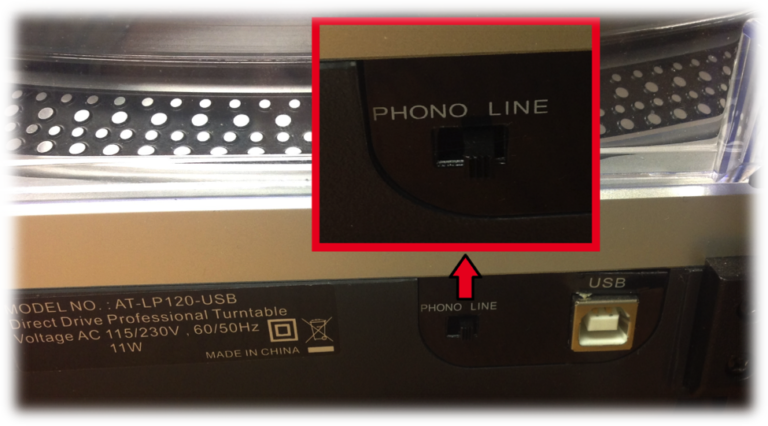Question: What does the PHONO/LINE switch mean on Audio-Technica Turntables?
Answer: Setting up your Audio-Technica turntable properly will ensure that you get the most out of your listening experience. The PHONO/LINE switch turns the turntable’s internal RIAA preamp off/on, thus providing the correct equalization for your turntable’s current setup.
Setup #1: When you plug the turntable’s analog (RCA) connectors into an input on a stereo receiver labeled “PHONO,” you will want to disengage the turntable’s internal RIAA preamp. A PHONO input on a stereo receiver has its own RIAA preamp, so there’s no need for the turntable to supply one. Set the PHONO/LINE switch to PHONO.
Setup #2: When you plug the turntable’s analog (RCA) connector into any other input on a stereo receiver (Aux, CD, tape, etc.) or directly into powered speakers, you will need to engage the turntable’s RIAA preamp. These inputs are for line-level signals, so the turntable needs to supply the required preamplification. Set the PHONO/LINE to LINE.
 You may ask yourself, “What is an RIAA preamp and why does this even matter?” Turntables require an RIAA preamp in order to properly reproduce the imbedded content on a vinyl record. All of Audio-Technica’s current line of turntables are equipped with an internal RIAA preamp which the user can either engage or disengage via the PHONO/LINE switch located on the rear of the turntable.
You may ask yourself, “What is an RIAA preamp and why does this even matter?” Turntables require an RIAA preamp in order to properly reproduce the imbedded content on a vinyl record. All of Audio-Technica’s current line of turntables are equipped with an internal RIAA preamp which the user can either engage or disengage via the PHONO/LINE switch located on the rear of the turntable.
In the 1950s, the Recording Industry Association of America (RIAA) introduced an equalization standard that could be applied to the original audio as it was pressed into a record. This equalization, which continues to be used to this day, reduces low frequencies and boosts high frequencies, thereby compressing the audio so that more of it can fit on a record. During playback, the exact opposite function is performed through an RIAA preamp, resulting in the reproduction of the original audio.
The following provides a simplified example:
When the original audio is pressed into the record, it is altered according to a specific code (RIAA Emphasis added) to save space on the record. When the record is played on the user’s turntable, the inverse code is applied (RIAA De-Emphasis added), allowing for the original audio to be heard through the speakers.
We hope you have found this information helpful, but if you require further assistance or have questions about any other Audio-Technica product, please feel free to contact our Audio Solutions Department – we’re always glad to help. And be sure to join us next time for another “Question of the Week”!
















































































































































.webp)































